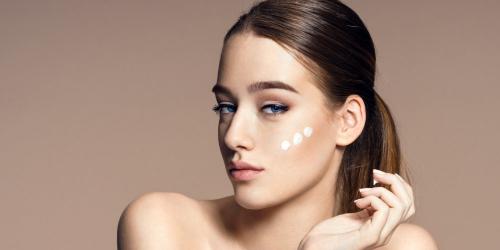As the days get longer and the summer looms, the beauty industry is turning a bit disconcerting. On our shelves, anti- brown spot treatments and creams and standardizing serums coexist with melanin boosters , which confirm the breakthrough that began in 2010.
But what is the point of trying to quell melanin runaways in the winter if it is to help him "climb" faster once the sunny days come back?
Can our skin go from one extreme to the other without consequence? A paradox of consumption that raised many questions to the editor, and deserved a clarification.
Chain reactions
Melanin is the pigment responsible for the coloring of the skin. It is made by melanocytes, located in the basal layer of the epidermis.
These cells are composed of dendrites (branches) that distribute the melanin grains to the surface of the skin. The production of the pigment results from a series of complex reactions: UV causes the expression of a hormone (alpha-MSH), which gives the order to an enzyme (tyrosinase) to oxidize tyrosine, a amino acid present in the body.
It then evolves to form melanin. The tyrosine-tyrosinase relationship is therefore an essential element that catalyzes the first stages of pigmentation. It is above all a "key" of the mechanism on which cosmetics can act.
To carry more fuel
"We can synthesize this tyrosine via our diet but the skin will be the last served, explains Aurélie Guyoux, scientific director of the brand Pur State.
Hence the interest of applying it locally via a cream Thus, the tyrosinase enzyme will have more tyrosine to "nibble" to make melanin. In short, we bring more fuel to a natural mechanism. Conversely, in the fight against blemishes (which result from a localized excess of melanin), the goal is to inhibit the expression of tyrosinase: tyrosine remains in the state, not degraded, and the rise of pigment is stopped.
But, above all, it is good to consider the phototype: " Stimulate the mechanism of tyrosine is possible only on skin that knows how to tan well "Tempers Dr. Françoise Roudil, dermatologist in Marseille.
Moreover, we can not deny the modulation mechanisms specific to the human body. "We will never produce a brutal and anarchic production of pigment, even by overexposing melanocytes to a high dose of precursors," insists Jean-Claude Le Joliff, cosmetics consultant and associate professor at Versailles Saint-Quentin University. No miracle therefore, without forgetting that all this production line is "UV dependent". Translation: without a minimum of sunlight, no tanning.
With or without "throttle".
Brown anti-stain care VS tanning accelerators: are they compatible?
But what about skin that already has spots? Will they be more numerous and more intense if we use an activator care?
"As long as the stain is not there, stimulating its melanin will have a beneficial and protective effect, since we submit to lower UV doses, explains Aurélie Guyoux. But once the pigment disorder is visible, it is too late and there is no point in going to tickle a melanocyte that tends to malfunction. "
Another more radical story: "When a stain appears, it is that the cell has suffered too much aggression and can no longer handle UV. You must choose your side: tan and accept the inevitability of hyperpigmentation, or take shelter from the sun to keep a uniform complexion, asserts Jean-Claude Le Joliff. After, nothing prevents reconciling intense tanning in the summer and removal of laser stains in winter, but it's just inconsistent, even a little silly. "
For Dr. Roudil, we must not dramatize: "They are two antagonistic mechanisms but not chemically incompatible or dangerous. It's more a matter of intuition and common sense. "
A tténuer contrasts
A good sense that has not stopped some brands from wanting to bring the extremes together. By Terry, the idea is to stimulate and regulate at the same time the proliferation of melanin grains for a more homogeneous pigmentation, thanks to a green pea extract, rich in cytokines.
At Esthederm, the approach is different, as Isabelle Benoît, scientific director, explains: "We have identified two types of melanin stimulation, either directly in the melanocyte under the influence of UV, or indirectly via the keratinocytes. "
The latter, subject to abnormal stress , send hormonal messages for melanocytes to make even more melanin. "For them, it's a little double trouble: they will darken under the influence of a double signal. It is this indirect stimulation that is expressed in the formation of spots. "
The bet of the brand? Optimize direct pigmentation while "deactivating" indirect pigmentation. Conclusion: the spot darkens less quickly than the rest of the skin, the color contrast is reduced. "Consumers have contradictory desires. The idea is to better educate them so that they can tan reasonably without aggravating their case, "concludes Isabelle Benoit.
Whatever the bias of the labs, the message to remember is, in our opinion, the following: the boosters of tan are not a pass to go to expose more with a sense of impunity. They do not change our vulnerability to the sun, which remains the major cause of premature aging, and therefore the formation of spots. We advise you to consider them simply for what they are, that is to say, allies more in a comprehensive care of the skin facing the sun
T he new simulators
You will understand, the tanning activators are primarily useful in prevention on skin without pigment disorders, to tan better for less risk. By the end of the 1980s, brands such as Lancaster or Esthederm were interested in stimulating melanin synthesis and developed top secret formulas. "Recently, the offer has expanded, recognizes Jean-Claude Le Joliff. Tyrosine derivatives are more numerous on the market, and there are also peptides in affinity with alpha MSH receptors, which act as a decoy and stimulate the pigment mechanism at the source. "
This is the bias of Lierac or Sampar, who have integrated these peptides, called promelanotropes, in their formulas. Others prefer to rely on the supply of pure tyrosine or precursor flavonoids, or on plant extracts such as carob tree, from which sugars (often inositol) are extracted which increase the available pigment stock and accentuate the color. tan obtained during the exhibition.
Combined with anti-radical shields, moisturizing agents and protective filters, they give birth to a new generation of "super solar".
"Ultimately, the goal of labs is to stimulate both the mechanism of tyrosinase and that of alpha-MSH to offer a nice tan with as little sun as possible. The idea is to better arm the skin against the dangers of the sun "concludes Aurélie Guyoux, at Etat Pur.
Sun care to have a beautiful skin : are they compatible or not?
Melanin Booster and Solar Capsules? Solar food supplements are antioxidant cocktails based on carotenoids and probiotics that improve, from the inside, the skin's defenses against free radicals released by ultraviolet and responsible for allergies and photo-aging. They are therefore quite complementary.
Melanin booster and self-tanner ? The latter causes a chemical reaction of "caramelization" on the surface, which disappears as the stratum corneum is eliminated. With an activator, we stimulate the "real" tan. No incompatibility so, but what's the point of cumulating real and fake tan?
Melanin booster and "light" serum? Not easy to know if these pro-shine serums, which speak skilfully of brightness, homogeneity, anti-dull action, shelter anti-stain assets. And if so, which ones and in what proportion? As a precaution, if you do a tan booster , put your serum in the cupboard in case it contains a tyrosinase inhibitor. Coupling it with a booster of the same enzyme proves to be counter-productive, the two formulas canceling out altogether.


